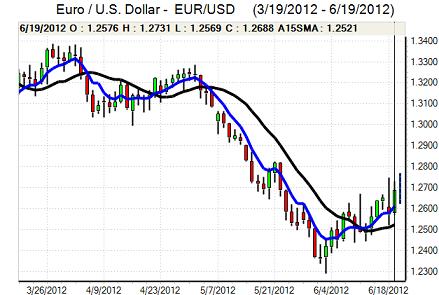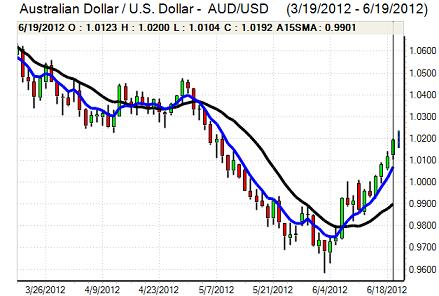EUR/USD
The Euro initially retreated during the European session on Tuesday on a set of negative news events, but the currency proved to be resilient and advanced sharply later in the session. There were reports that the full audit of Spanish banks would not be completed until September which had a significant negative impact on sentiment, especially as it reinforced fears that losses would be even larger than expected. As negotiations continued to form a Greek government, there were also reports that working group would be formed to push for bailout concessions which had some impact in offsetting optimism that a coalition would be formed.
The German ZEW index fell sharply for June with a reading of -16.9 from 10.8 the previous month which was worse than expected and the sharpest rate of decline for over five years. The Euro quickly regained ground following the release with speculation that the weak data, allied with a slowdown in inflation pressures would push the ECB to cutting interest rates and provide some support to the growth outlook.
There were media reports that ESM and EFSF funds could be used to buy bonds directly which helped bring peripheral bond yields down, but German officials denied the suggestion as uncertainty dominated. There was also no mention of such a plan in the final G20 communique which concentrated on promotion of growth measures.
The latest US housing starts data was weaker than expected with a decline to 0.71mn from 0.74mn previously, but it was still a solid release and permits strengthened to a four-year high. Federal Reserve policy remained an important focus and there was increased speculation that the Fed would move to announce additional quantitative easing beyond the expected extension to operation twist to keep longer-term maturities down.
The speculation had an important impact in underpinning risk appetite as well as directly weakening the US currency and there will certainly be caution ahead of the decision on Wednesday. The Euro pushed to highs above 1.27 on Fed expectations before dipping back below this level with little change on Thursday.

Source: VantagePoint Intermarket Analysis Software
Call now and you will be provided with FREE recent forecasts
that are up to 86% accurate* 800-732-5407
If you would rather have the recent forecasts sent to you, please go here
Yen
The dollar found support on dips towards 78.80 against the yen on Tuesday, but was unable to make any significant headway. The yen proved to be relatively resilient even though there was a general improvement in risk appetite.
The latest Bank of Japan minutes stated that some members wanted all options to be considered for underpinning the economy. The latest trade deficit was slightly wider than expected, although exports maintained a more favourable tone which helped lessen the currency impact.
The dollar held just below 79 against the yen on Wednesday ahead of the Federal Reserve interest rate decision with the US and Japanese currencies both likely to gain support if there are no fresh policy initiatives.
Sterling
Sterling dipped weaker ahead of the UK data releases on Tuesday with speculation over weaker than expected inflation data. The latest headline consumer inflation rate did decline to 2.8% for May from 3.0% previously and was the lowest rate since late 2009 while the core rate was just above the 2.0% level.
The decline in inflation reinforced expectations that the Bank of England would move towards additional quantitative easing, potentially as early as the July meeting. In this context, the MPC minutes will be watched very closely on Wednesday. There was some initial negative impact on Sterling, but the currency recovered quickly on expectations that there would be monetary policies elsewhere and it also gained from a net improvement in risk appetite.
There has been a greater mood of confidence surrounding the financial sector which helped push Sterling back to highs above 1.5750 against the US currency as the Euro was unable to make much headway against Sterling.
Swiss franc
The dollar was blocked in the 0.9550 region against the franc on Tuesday and retreated back to lows close to 0.9450 during the New York session. The Euro failed to gain any benefit from a rally against the US currency as it remained trapped below the 1.2010 level.
The Swiss currency remained strong despite some reports that there would be support measures for peripheral bonds and this continues to suggest underlying capital flows into the Swiss currency. Any sharp downturn in the ZEW business confidence index would maintain pressure to prevent franc gains and support competitiveness.

Source: VantagePoint Intermarket Analysis Software
Call now and you will be provided with FREE recent forecasts
that are up to 86% accurate* 800-732-5407
If you would rather have the recent forecasts sent to you, please go here
Australian dollar
The Australian dollar resisted any renewed challenge on support below 1.01 against the US dollar on Tuesday and rallied steadily to a high around the 1.02 level during US trading. As well as gaining backing from a generally weaker US currency, there was an improvement in risk conditions on expectations of global central bank action to underpin demand.
The housing starts data was sharply weaker than expected which had some negative impact on the Australian dollar. International trends tended to dominate with the currency broadly resilient ahead of the Federal Reserve decision.



